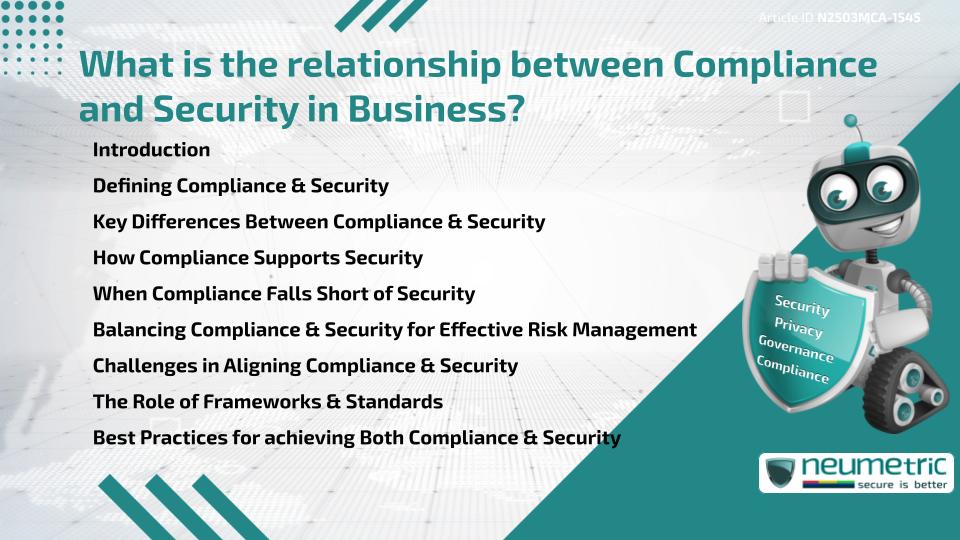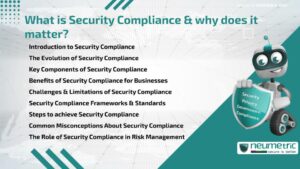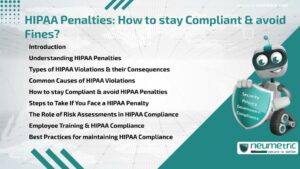Table of Contents
ToggleIntroduction
Businesses often struggle to understand what is the relationship between Compliance and Security. While both are essential for protecting Sensitive Information, they serve distinct purposes. Compliance ensures adherence to Legal & Regulatory Requirements, whereas Security focuses on safeguarding Data & Systems from Threats. This article explores their interplay, differences & the best ways to align them effectively.
Defining Compliance & Security
Compliance refers to meeting the Legal, Regulatory & Industry-specific Standards imposed on an Organisation. It establishes minimum requirements that Businesses must follow to operate lawfully. Examples include the General Data Protection Regulation [GDPR], the Health Insurance Portability & Accountability Act [HIPAA] & the Payment Card Industry Data Security Standard [PCI DSS].
Security, on the other hand, involves implementing measures to protect Data, Systems & Networks from Cyber Threats, Unauthorised Access & Breaches. Security is an ongoing effort that evolves with new Risks & Technological advancements.
Key Differences Between Compliance & Security
- Purpose – Compliance ensures adherence to regulations, while Security aims to protect assets from Threats.
- Scope – Compliance is dictated by external authorities; Security is an internal, strategic approach.
- Flexibility – Compliance follows strict guidelines, whereas Security requires adaptability.
- Assessment – Compliance is typically verified through Audits; Security is tested through Risk Assessments & real-time Monitoring.
How Compliance Supports Security
Although Compliance & Security are distinct, they are interconnected. Compliance Frameworks provide a foundation for Security by establishing guidelines for Best Practices. Regulations like GDPR require Organisations to implement strong Security Measures to protect Personal Data. Meeting Compliance Standards often enhances Security Posture by enforcing critical protections such as Encryption, Access Controls & Incident Response Plans.
When Compliance Falls Short of Security
Compliance alone does not guarantee Security. Many Organisations achieve Compliance by checking off Regulatory Requirements without implementing deeper Security controls. A System may be Compliant today but vulnerable to evolving Threats tomorrow. Security requires continuous improvements, real-time monitoring & proactive defense strategies beyond what Compliance mandates.
Balancing Compliance & Security for Effective Risk Management
Organisations must strike a balance between Compliance & Security. Relying solely on Compliance can leave gaps in Security, while focusing only on Security may lead to Regulatory Violations. Effective Risk Management requires integrating Compliance Requirements into a broader Security Strategy, ensuring both Regulatory Adherence & robust protection against Threats.
Challenges in Aligning Compliance & Security
- Changing Regulations – Compliance Requirements evolve, making it difficult to maintain alignment with Security Practices.
- Resource Constraints – Small & Medium-sized Businesses may lack the budget or expertise to implement comprehensive Security beyond Compliance.
- False Sense of Security – Organisations may assume Compliance equals Security, leading to overlooked Vulnerabilities.
- Complexity of Standards – Businesses operating globally must navigate multiple Regulatory Frameworks, increasing complexity.
The Role of Frameworks & Standards
Frameworks like the National Institute of Standards & Technology [NIST] CyberSecurity Framework & ISO 27001 help bridge the gap between Compliance & Security. These standards provide Best Practices that Organisations can use to align Security efforts with Regulatory Requirements. Adopting such Frameworks helps Businesses move beyond minimal Compliance & establish a strong Security Culture.
Best Practices for achieving Both Compliance & Security
- Adopt a Risk-Based Approach – Prioritise Security Measures based on Risk rather than just Compliance Checklists.
- Continuous Monitoring – Implement real-time Security monitoring to detect & mitigate Threats.
- regular Audits & Assessments – Conduct Security Audits beyond Compliance Requirements to identify Vulnerabilities.
- Employee Training – Educate Employees on both Compliance Requirements & CyberSecurity Best Practices.
- Leverage Technology – Use advanced Security Solutions such as Threat Intelligence, Intrusion Detection & automated Compliance Tools.
Takeaways
- Compliance & Security are closely related but serve different purposes.
- Compliance establishes regulatory baselines, while Security provides proactive protection.
- Meeting Compliance does not always mean an Organisation is secure.
- Businesses must integrate Compliance into a broader Security strategy.
- Continuous Monitoring, Risk-based approaches & Security Frameworks help bridge the gap between Compliance & Security.
FAQ
What is the relationship between Compliance & Security?
Compliance ensures Regulatory Adherence, while Security protects Systems & Data from Threats. They complement each other but serve different roles.
What is the biggest challenge in aligning Compliance & Security?
One of the biggest challenges is the misconception that Compliance alone is enough. Security requires ongoing effort, investment & adaptability.
How can Businesses ensure continuous Compliance & Security?
Regular Assessments, real-time Monitoring & adopting Security Frameworks help Organisations stay compliant & secure in a changing Threat landscape.
What are some Best Practices to integrate Compliance & Security?
Implement Risk-based Security, conduct Regular Audits, provide Employee Training & leverage advanced Security Technologies.
What are the Risks of focusing only on Compliance?
Organisations that focus only on Compliance may overlook emerging Threats, leaving systems vulnerable to Cyberattacks despite Regulatory Adherence.
Can an Organisation be secure without being Compliant?
Yes, an Organisation can have strong Security Measures in place but still fail to meet Regulatory Requirements. Compliance ensures Legal Accountability.
Does Compliance guarantee Security?
No, Compliance provides a baseline but does not account for evolving Threats. Security requires continuous improvements beyond Compliance mandates.
Why is balancing Compliance & Security important?
Balancing both ensures that Organisations meet Regulatory Requirements while maintaining strong CyberSecurity protections against Threats.
How do Compliance Frameworks help with Security?
Frameworks like NIST & ISO 27001 provide structured guidelines to align Security efforts with Regulatory Requirements, reducing Risks & improving Resilience.
Need help?
Neumetric provides organisations the necessary help to achieve their CyberSecurity, Compliance, Governance, Privacy, Certifications & Pentesting goals.
Organisations & Businesses, specifically those which provide SaaS & AI Solutions, usually need a CyberSecurity Partner for meeting & maintaining the ongoing Security & Privacy needs & requirements of their Clients & Customers.
SOC 2, ISO 27001, ISO 42001, NIST, HIPAA, HECVAT, EU GDPR are some of the Frameworks that are served by Fusion – a centralised, automated, AI-enabled SaaS Solution created & managed by Neumetric.
Reach out to us!





